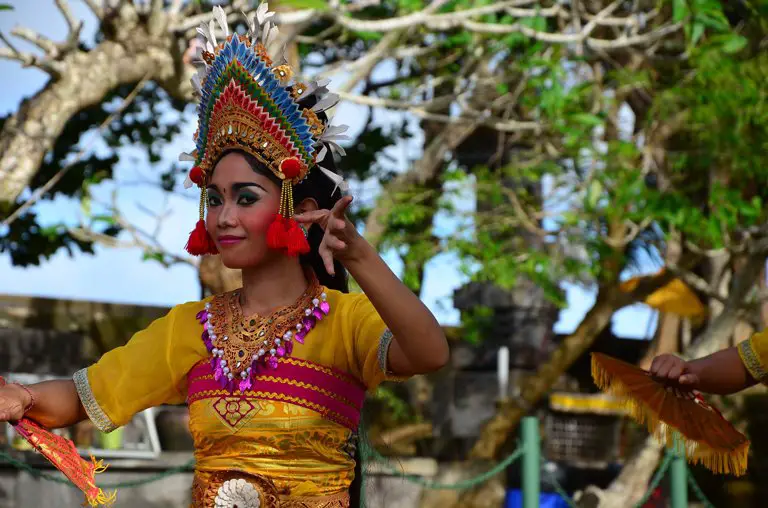TRADITIONAL DANCE
Each trip is a great opportunity to know the culture of the place you are visiting, and one of the best ways to discover the Island of the Gods’ culture is through dance. In these dances, you can appreciate the Hindu roots of the Balinese religion, enjoy the elegance, and the show that the Balinese artists create. The traditional Balinese dances are part of the religious and artistic expression of the island, and there is a great variety of Balinese dances. These are divided into three main categories: Wali – the sacred dances, Bebali – the semi-sacred dances, and Balih-Balihan – the entertainment dances.
Wali - Bali's sacred dances
The sacred dances of Bali, called Wali dances, are ancient. It started to be practiced between the 8th and 14th centuries and it’s only practiced inside the temples. Very well trained dancers perform these types of dances, as a religious symbol, and are presented to the gods as intangible offerings. The Wali sacred dances include various types of dance, such as Rejang, Barris, Pendet, Barong, or Sanghyang Jaran.
Rejang - The most sacred dance
Rejang dance is one of the most sacred dances in Bali. It is performed inside the temples to entertain the visiting gods and spirits. This dance is performed by girls who are not yet menstruating and who present themselves to the gods. The dancers wear white clothes and floral head decoration that, in some villages, can be around a meter tall. Rejang is a slow dance with elegant but simple movements. It is accompanied by Balinese musical instruments such as the Gong Kebyar and the Gamelan Selonding. The dancers don’t need prior training for this type of dance, as it is believed that the spirit of ngayah (cooperation) will guide the girls to dance in harmony. This dance is taught from generation to generation so that tradition is not lost.
Baris - The warrior's dance
Baris is a traditional war dance that represents warriors who are preparing to face the enemy and symbolizes the warriors who fought for Bali’s kings. This dance is usually performed by a group between 8 to 40 men dressed in traditional warrior’s costumes with decorations on their chest, back, and head. The dancers come out on stage holding spears or swords and shields, and their firm steps recreate the sound of men going to war. Baris dancers train rigorously to obtain the skill and flexibility required for the elegance of this dance and to be able to transmit the expressions of the warriors. The Baris dance is played by traditional gamelan music, and the orchestra must be entirely in tune with the warriors’ mood swings and expressions (fierceness, pride, alertness, or compassion). This dance is performed in cremation ceremonies, but also in other ceremonies to welcome the gods and ancestors to earth.
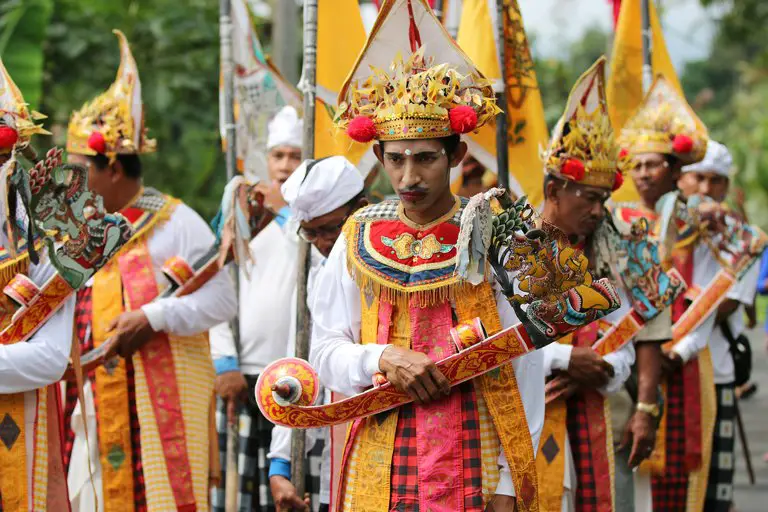
Pendet - The welcome dance
Pendet is a welcome dance that is performed at the beginning of ceremonies or social events to invite gods and spirits to enjoy the performance. This dance is usually performed by 4 or 5 women who carry a small silver bowl called bokor filled with flower petals that they spread during the dance. The floral offerings of this dance have the purpose of purifying the temple or the building where the ceremony takes place and welcoming both gods and guests. Unlike other Balinese dances, the Pendet doesn’t require intense preparation and can be performed by young and older women.
Barong - The fight between good and evil
Barong is one of the best known Balinese dances and represents the struggle between good and evil, according to Balinese mythology. Barong is known as the protective spirit of the villages of Bali and depending on each island’s regency, can have the figure of a wild boar, tiger, dragon, or lion. The lion is the most popular and comes from Gianyar’s regency where Ubud is located. The lion has a red head, with many jewels and decorations. In the endless battle represented in this dance, Barong fights with the witch Rangda, who represents evil. The dance begins with two playful monkeys who are mocking Barong. Then Rangda appears using black magic with male dancers and orders them to commit suicide. However, Barong uses protective magic that makes men invincible. The dance ends with a final battle between Barong and Rangda from which Barong is the winner and evil is defeated.
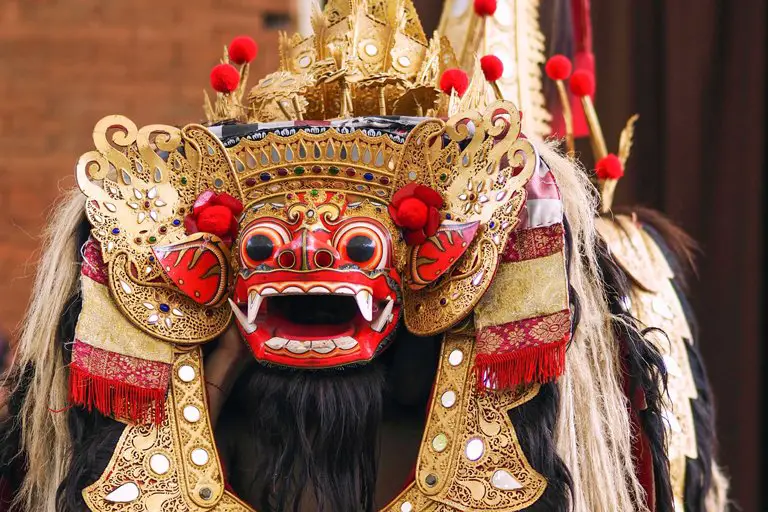
Sanghyang Jaran - The purification dance
Long before the arrival of modern medicine, the Balinese believed that all diseases and epidemics were caused by human sin. Also, they believed that everything on earth has a spirit and that all these spirits live in an invisible world. Sanghyang Jaran is one of the sacred dances and is performed in the village temples during ceremonies to cleanse the unseen world that has been contaminated by human sin so that epidemics in the villages can be avoided. The Sanghyang Jaran is performed by a choir of more than 20 singers and a dancer who is usually a priest, and the whole action circles a bonfire. Amid the tranquil atmosphere and the transcendental singing that is believed to bring down the spirits from the sky, a man on a horse made of coconut leafs appears and dances in the fire. It symbolizes the exorcism of the evil spirits that can bring disease to villages. It is said that both the chorus and the man dancing in the fire fall into a trance and cannot remember the performance or dancing with their feet in the fire while being conscious.
Bebali - Bali's semi-sacred dances
Bebali Balinese dances date back to the 14th-19th centuries and are performed in the temples during several rituals, but also as entertainment. Usually, Bebali dances have a story and roles that are performed in dance form. Although these semi-sacred dances are accessible to tourists as part of their entertainment, they still preserve their traditional values. Some of the semi-sacred dances are Topeng, Gambuh, or Wayang Wong.
Topeng - The mask dance
Topeng dance, also known as the mask dance, is usually performed during important ceremonies. Topeng in Indonesian means mask, and in this type of dance, artists use paper or wooden masks. This type of dance is a very popular way of telling stories of historical events and legends of Balinese mythology, but sometimes they represent political figures and public people in a humorous way. The dancers have a unique talent for imitating the characters they represent and can reproduce even the voice tone of the person they imitate. This dance is more of a theatrical performance but is considered a dance.
Gambuh - Balinese royal court dance
Gambuh dance originated in the 17th century at the Balinese royal court and it is a show that combines dance, music, and dialogue. This kind of dance narrates stories of everyday life, love, and the political intrigues of the court. To perform this type of dancing, an orchestra needs more than 15 musicians and between 15 and 20 actors, depending on the story to be told. Today these performances last two or three hours, but in the old days they lasted up to a couple of days. Due to their complexity and because it is very difficult to interpret as the text is written in Kawi, an ancient language of Java, these types of shows are almost extinct.
Wayang Wong - The puppets dance
In the ancient language of Java, Kawi, Wayang means shadow but is also used to refer to a puppet theatre play. On the other hand, the word Wong means humans, and therefore Wayang Wong is translated as a performance of human puppets. In this type of show, there are no puppets, but artists who represent the stories that were formerly performed in the villages and they usually contain a moral. The performers bring to life the stories inspired by the past and the heroes of mythology, and they are dressed in elaborate costumes and accompanied by a gamelan orchestra. In this theatrical performance, besides learning the dance routines of their specific character, the actors must also learn certain dialogues and sing. Those who perform in a sacred Wayang Wong are chosen based on their lineage, and it is said that long ago the ancestors made a pact to serve the temple and the sacred spirits through dance. The Wayang Wong was recognized by UNESCO as Intangible Cultural Heritage.
Balih-Balihan - Dances used for entertainment in Bali
This type of dance revolves around a story, a novel, or a mythological tale and is performed mainly to entertain tourists. These types of performances can be seen in different places on the island and although they are quite touristy, it is worth attending one of these shows, since it is a good way to learn more about Balinese culture and mythology. There are many types of Balih-Balihan dance, but the most outstanding are Legong, Kecak, Kebyar, Jauk, Oleg, Yoged, or Geng-Gong.
Legong - The most expressive dance
Legong dance is the highest expression of Balinese dance refinement and dates back to the 13th century. At that time, the most beautiful girls in the villages were chosen to dance in the palaces and were trained in the palatial dance until they could perform perfect movements. This dance is one of the most venerated classical pieces on the island and is known for its physically demanding postures and fast movements that require a significant level of flexibility among its performers. This dance includes very complex movements of fingers and toes, but also very well trained facial expressions. In Legong’s performances, the dancers are perfectly synchronized, so much that they seem to be reflecting in a mirror.
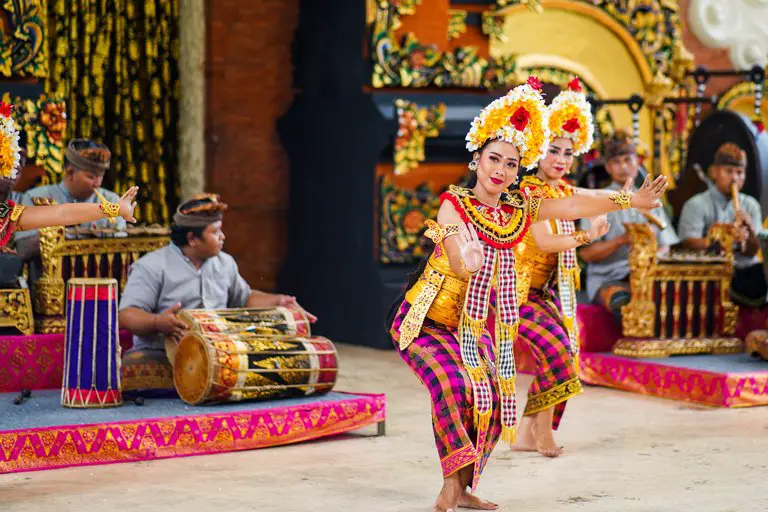
Kecak - The trance dance
Kecak dance is one of the best known and most interesting Balinese dances that can be seen on the island. This dance is characterized by the synchronization of its chorus made by a hundred men who sing in unison. This show recreates the story of Ramayana, an epic that belongs to the oldest Hindu literature. This performance is a trance ceremony that takes men who perform it to ecstasy. In this type of show, the performers wear only a sarong covering their legs and they often end up dancing in the fire. One of the best places to witness the Kecak dance is the Uluwatu temple.
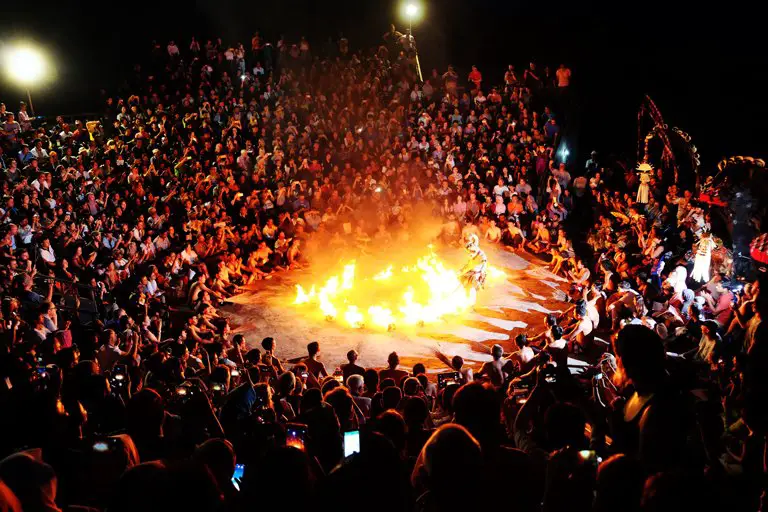
Kebyar - The dance of perfect movements
Kebyar is a dance performed by one man, and it is quite a complex dance as he interprets every note of the music with his facial expressions and body movement. In some of Kebyar’s performances, the dancer remains most time of the show in a squatting position and with his legs crossed, moving only his arms and torso. Kebyar’s dancers have to be very familiar with the music that accompanies them as they have to reflect the melody with their gestures and hand movements. To become a Kebyar dancer, it is said that a man has to know how to play each instrument from the orchestra. This dance requires great control of the body and strength.
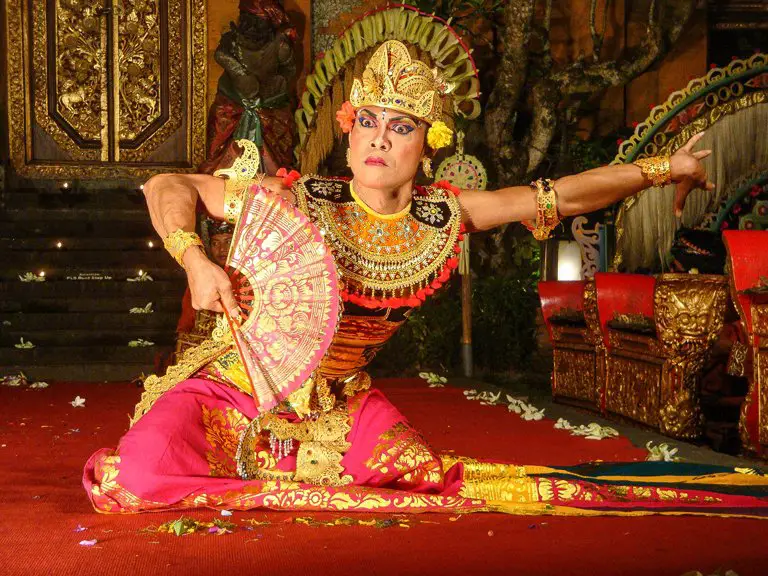
Jauk - The mask dance
Jauk is a dance that, like Kebyar, is performed by one man. The difference between these two dances is that in the first one, the artist wears a mask and has to play a character using only body movements. In this kind of dance, the dancer cannot use the facial expressions or the stare which makes it more complicated to play his role. There are two types of Jauk dance: Jauk Keras, in which the artist wears a red mask, the movements are faster and the gamelan music is more intense; and Jauk Manis which is performed with a white mask and slower rhythm.
Oleg - The bumblebee dance
Oleg is a sensual dance that imitates the dance of two bumblebees in which the man becomes obsessed with a woman and she gracefully keeps him away. The movements of this dance require a lot of flexibility on the part of the female dancer and the male dancer’s gallantry. The choreography is full of vibrant and dynamic movements. Oleg can be performed at temples, festivals, hotels, and official events. This is an entertainment dance, and although it is performed in temples it’s only for enjoyment and is not associated with any sacred ceremony.
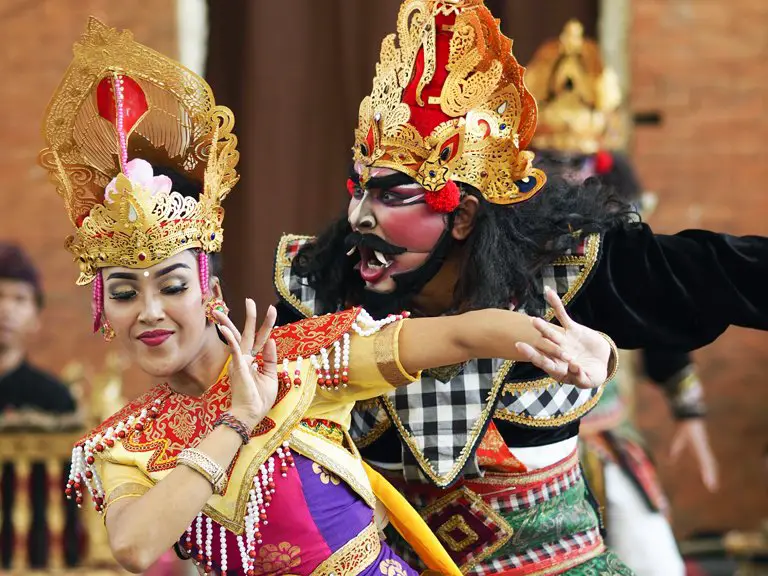
Geng-Gong - The frog dance
Geng-Gong dance recreates a Balinese fairy tale in which a princess marries a frog. Geng-Gong is the name of a musical instrument that reproduces the sound of a frog and is part of the music that accompanies this dance. The steps of the frog dance integrate movements of the Topeng dance, mask dance, Baris, and warrior dance, complemented by a mask representing a frog. The moral of the story represented in this type of performance is that a person should not be loved only for its physical appearance but for its soul, just like the princess who loved a frog.
Cendrawasih - The Bird of Paradise dance
Cendrawasih dance is performed by two dancers and it’s a symbol of the love’s paths. The Cendrawasih Dance is a dance full of Balinese movement and music, and can be enjoyed in artistic performances not only in Bali but also abroad. Cendrawasih means bird of paradise and this bird, very important in Balinese mythology, is the main character of this dance. Significantly, the dancers’ movements are a replica to the moves of a bird paradise couple that are performing a marriage ritual. The artists’ costumes are also designed according to the appearance of this bird, having the same colors as the paradise bird and head decorations in a crested form.
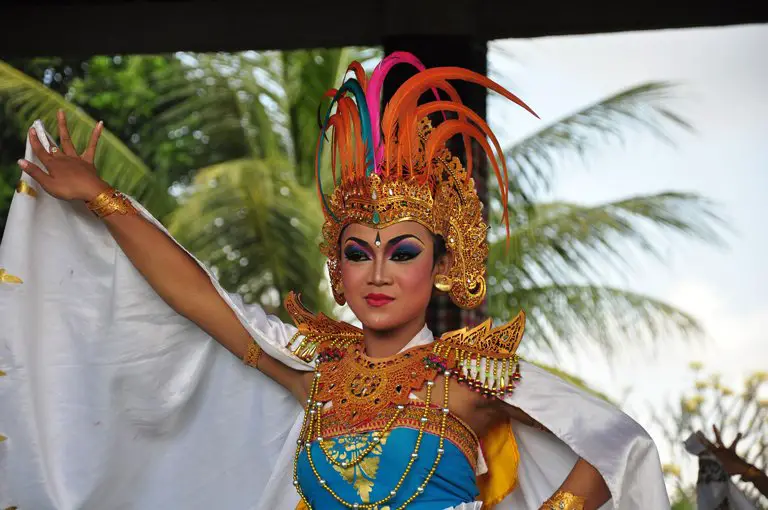
Yoged - The harvest celebration dance
Yoged dance is usually performed at social events, at village festivals, but mostly for celebrating the harvest. This is a fun and seductive dance in which the young female dancers start by fanning themselves and dancing by moving their hips to attract men into dancing with them. Many times, the dancers allure men from the crowd to dance with them, which results in the audience’s amusement.
